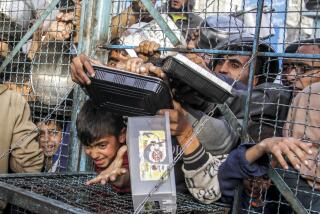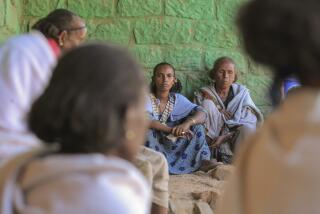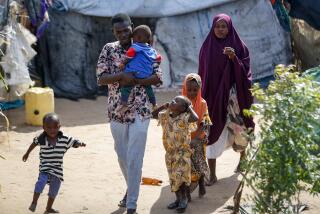U.S.-Led Convoy Reaches Baidoa, Center of Famine : Somalia: The heavily armed troops meet little resistance as they enter the city, where 60 people have been dying each day amid attacks on relief officials.
- Share via
BAIDOA, Somalia — With jets and helicopters roaring overhead, a U.S.-led convoy of troops, armored cars and high-tech weapons rumbled into this besieged city in the heart of southern Somalia’s famine zone early today, seeking to bring peace, hope and food.
The deployment, which moved northwest from Mogadishu through rural brushland and past camel herds, was the largest since Operation Restore Hope began with a massive beach landing in Mogadishu a week ago.
It was the most important--and potentially most dangerous--mission undertaken so far by the growing American military garrison in Mogadishu.
And it brought American forces here into the middle of Somalia’s devastating starvation, which has claimed 300,000 lives and threatened 2 million more. The death toll grows steadily, from 20 a day in Baidoa only a few weeks ago to 60 a day now.
Relief agencies, which had complained loudly about the delay in getting forces into the isolated city, also hoped the mission would end the attacks on their personnel and property that have escalated since the Marines arrived in the country.
The Marines encountered little resistance when they began pressing into Baidoa.
The procession of troops in their armored vehicles snaked into the eastern edge of the city by dawn. The convoy, with at least one fluttering American flag very visible, was greeted by scattered, friendly Somalis, who waved at it as it passed.
Unlike when U.S. Marines landed last week in the Mogadishu darkness--right in the midst of a horde of jostling, television cameramen carrying bright lights--the force that rolled into Baidoa had fewer problems with the international media.
Baidoa, unlike Mogadishu, is known to be a considerably more lawless, dangerous spot, and members of the media--although they provided detailed coverage of the convoy’s arrival--had deliberately tried to lie low. Their conduct also may have been more circumspect because some journalists came under fire on Tuesday on their trip into Baidoa.
American officials had warned relief workers and ordinary Somalis to stay off Baidoa’s streets from midnight on or face the consequences of getting caught in any military action.
The armed convoy of several hundred troops encountered few problems making their forays around Mogadishu, then on to the Bela Dogle airport halfway between Mogadishu and Baidoa. Arriving from the coastal capital and Bela Dogle with a massive show of force, soldiers were confident that any potential challengers would disappear from the rocky streets here.
The night before the mission, Col. Greg Newbold, commander of the forces, told his officers: “It’s time we got there (Baidoa) to help. It’s a noble mission,” he assured them. “It’s a noble thing to do.”
As the troops entered Baidoa at first light, the men clutching their M-16 rifles as others drove light-armored vehicles and Humvees mounted with missiles, they waved to the bedraggled well-wishers along the route. One soldier threw candy to some young spectators, who approached it and eyed it suspiciously. Local residents, barefoot and wearing ragged, single-sheet wraps, serenaded the troops. “Welcome! Welcome! Welcome!” they sang.
“It was one of the nicest receptions you could ask for,” said Cpl. Jeff Mann, 26, of Birmingham, Ala. “I knew the people would be glad to see us, but it was a sight to see.”
The Marine presence also was pleasing to the Somalis, locals said.
“It’s very good they are here,” said Isaak Abdul Osman, a 25-year-old farmer who smiled as he watched the passing convoy. Osman had lost his crops to drought this year. “We have not been able to do anything because of a lack of security and a lack of food.”
Added 30-year-old Hawa Hanar: “We have been waiting so long for them to come help us.”
Hanar, a mother of five, lost her husband in a bomb blast in Baidoa earlier this year.
To help pave the way for the troops, U.S. special envoy Robert Oakley flew to Baidoa early Tuesday, landing under the cover of two F-14 Tomcat fighter jets from a U.S. aircraft-carrier group just off the Somali coast. Pausing briefly to speak to reporters, the ambassador, wearing a baseball cap bearing his last name, predicted that the convoy would secure the city in the strategic heartland of Somalia’s famine without incident.
“My purpose in coming here is to help the Somali people to understand the U.S. military is an instrument of peace,” Oakley said, before speeding off in a jeep to meet with the leaders of clan armies that have occupied and occasionally terrorized the famine-struck city. “As it was in Mogadishu, I’m confident they will understand that here.”
In related actions Tuesday:
* Famine relief groups briefed military officials on the staggering need in Somalia, saying there are numerous areas beyond Mogadishu and Baidoa--sites Westerners may not even yet know about--where death stalks millions of hungry, ailing Somalis.
* Pentagon officials said they are keeping a close watch on the increasing number of guns and gunmen creeping back onto the streets of Mogadishu. Most of the arms, however, reportedly are smaller, less lethal than previously.
* In Southern California, a second wave of Port Hueneme-based Seabees began taking off for Somalia, signaling the beginning of an effort that will land 190 Seabees in the African nation by early Thursday.
In Baidoa, the potential for attacks on the Marines, and the Army units arriving with them, is greater than in Mogadishu. And as the troops press into the countryside, they may face even greater dangers from the armed gangs that are vacating Baidoa for cities deeper in the famine zone.
But U.S. forces were looking at the Baidoa operation as an indication of what troops can expect when they go into other famine areas.
“If we don’t have any trouble in Baidoa, we won’t have any trouble anywhere,” said Marine Sgt. Jorge Atondo, 35, of Los Angeles, assigned to the first wave of helicopter-born assault troops to land at Baidoa’s airport early today.
From Mogadishu, the Marine-led convoy had departed for Baidoa with great spirit. They exchanged “high fives” with Somalis who lined the capital’s main roads to see them off. Trailed by scores of pickup trucks and jeeps bristling with television cameras, the combined force of about 700 U.S. Marines and French Foreign Legionnaires passed through a shower of mixed emotions.
The French troops, viewed by most Somalis as a symbol of colonial rule in Africa, either were ignored or quietly insulted as they passed through the teeming streets, which are jammed with more and more pedestrians, shoppers and sellers each day during the week since outside forces landed in a city two years in anarchy.
But the Americans received the heartiest praise from residents of this overwhelmingly Islamic nation, clearly broken and exhausted by war. “Hey man, you’re my clan!” shouted one Somali street vendor as U.S. Marine troop trucks weaved through the shell-pocked streets.
Marine forces were followed by Army units from the 10th Mountain Division, based in Ft. Drum, N.Y., which provided aid to southern Florida after Hurricane Andrew.
The long-awaited arrival of the Mareykanka, the Somali word for Americans, brought hope Baidoa, a ragged, battered city of 60,000, where a Somali Red Cross “death truck” makes a grim round of feeding centers twice a day to collect the bodies. In recent days, as the sun has set, the staccato sounds of automatic gunfire have punctuated the air of the city.
The Baidoa Hospital had three new gunshot victims Tuesday from overnight shootings. The body of a fourth, covered by a grass mat, left the hospital grounds on a cart pulled by a small donkey. Of the 100 beds at the hospital, 88 were occupied by shooting victims.
But relief agencies thought the U.S. military presence would drive guns off the street and end the looting of relief supplies that has plagued the effort to feed starving Somalis.
More important, officials said, it would open up the dangerous, narrow road that runs 200 miles from the Mogadishu port to Baidoa. Most food has been arriving by air, which costs four to five times as much as shipment by road.
That will mean that the nine relief agencies operating in Baidoa would have more money for development projects that will help Somalis get back on their feet and be self-sufficient again. Of the 60,000 residents of Baidoa, about 75% are refugees from the countryside.
At a briefing, Col. Fred Peck, spokesman for the Joint Task Force, said U.S. Air Force planes continued to ferry soldiers into Mogadishu International Airport and the forward staging air base in Bela Dogle.
Peck said that 630 fresh troops and 1 million pounds of cargo had been unloaded at the Mogadishu airport in the previous 24 hours, bringing the current force in the country to more than 4,000.
Troop contributions from other nations continued to trickle in, adding 62 Italians, 90 Canadians and several hundred Saudis to the military force authorized by the United Nations to provide cover for the massive Somali relief effort.
At the Pentagon, officials announced that they have ordered the 4th Psychological Operations Group (Airborne) to join in the Somali relief effort. Elements of the unit, which specializes in making and distributing leaflets, making radio broadcasts and communicating with local populations, are already en route to the region.
Lt. Gen. Martin L. Brandtner, operations director for the Joint Chiefs of Staff, said U.S. troops are surveying a Mogadishu radio station with an eye to repairing and using it for American broadcasts.
Kraft reported from Baidoa and Fineman from Mogadishu. Times staff writer Melissa Healy in Washington contributed to this report.
More to Read
Sign up for Essential California
The most important California stories and recommendations in your inbox every morning.
You may occasionally receive promotional content from the Los Angeles Times.











